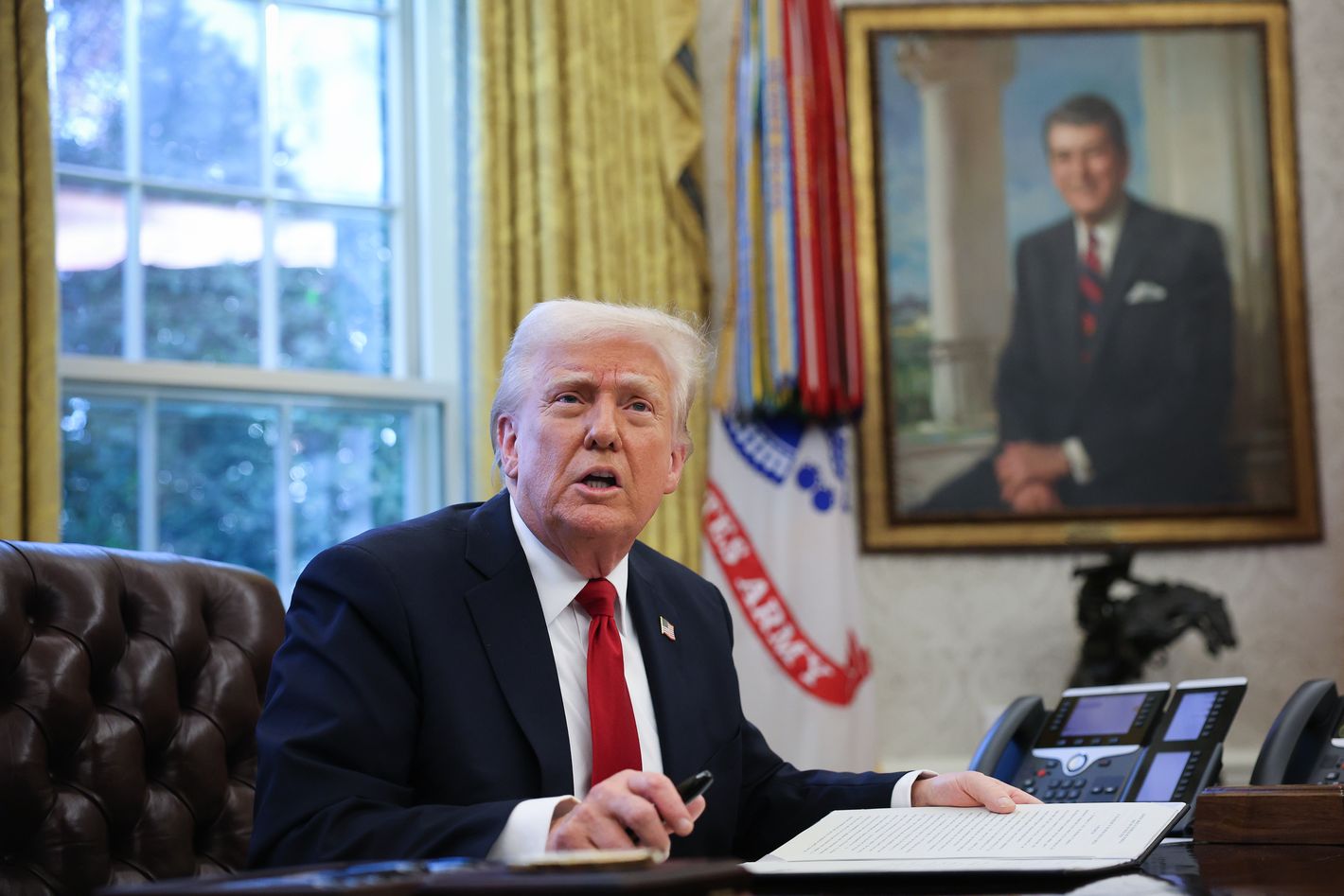Photo: Win McNamee/Getty Images
For all his success in imposing his will on the federal government, Donald Trump may be deliberately engineering his own political downfall by mishandling the very job he was most certainly elected to perform: stewardship of the economy. The risks he’s running were impressively summarized by Washington Post economics columnist Heather Long:
President Donald Trump is pushing the economy to a breaking point with sweeping tariffs and rapid cuts to immigration and the federal workforce. There is growing fear of not just a recession but stagflation, a frightful situation — not seen in the United States since the 1970s — in which the economy contracts and people lose jobs but prices remain high.
This is a self-inflicted wound from Trump. Many of his economic advisers, including Larry Kudlow and Stephen Moore, are urging him to show restraint on tariffs. But Trump is set to unleash the biggest increase in tariffs since the Depression era on Wednesday. He’s calling it “Liberation Day.” It may turn out to be Stagflation Day.
“Stagflation” (an economy characterized by both rapidly rising prices and slow growth) is the horrible bogeyman that economic policy wonks scare one another with around the campfire late at night. In theory, it’s not supposed to happen because fiscal and monetary policies tend to push the economy either toward growth with price inflation or toward recession with low price inflation … or, ideally, toward steady growth accompanied by stable prices.
But stagflation can definitely happen, as the United States proved in the 1970s when inflation spurred by oil-price shocks and unemployment boosted by restrictive policies from the Federal Reserve gave the country the worst of all possible economic worlds. There were actually two moments of extreme stagflation: in 1975, when the core Consumer Price Index rose 9.1 percent while unemployment reached 8.5 percent, and in 1980, when core CPI was up 12.4 percent and unemployment was at 7.1 percent. Although the causes of this past era of stagflation were complex and some of the foreign and domestic policies of Richard Nixon were significantly responsible, its political consequences fell most heavily on his successors Gerald Ford (in office from August 1974 to January 1977) and Jimmy Carter (January 1977 to January 1981). It’s not an accident that both men became the only electorally defeated incumbent presidents between Herbert Hoover and George H.W. Bush.
Photo: Bettmann Archive/Getty Images
To assess the political risks associated with stagflation, it’s important to understand that, despite their bumbling reputations as presidents, Ford and Carter took impressive political assets into their failed reelection campaigns. Ford inherited Nixon’s massive landslide coalition from the 1972 presidential election and added a fresh image of openness, honesty, and bipartisanship. Carter put together a mind-bending coalition based on his strength in southern states that had been lost to Democrats for years and have not gone Democratic for any presidential candidate since. It took some work for either president to lose. But while both had other missteps (e.g., Ford’s pardon of Nixon and Carter’s mishandling of the Iran hostage situation), it’s evident in retrospect that stagflation made both vulnerable to primary challenges (Ronald Reagan’s against Ford, Ted Kennedy’s against Carter) and ripe for defeat.
In comparing past presidents with Trump, it is very clear his 2024 win was uniquely attributable to the belief (to some extent based on dubious memories) that the U.S. economy had done well during his previous term in office, particularly compared with Joe Biden’s inflation-plagued term. It’s hard to imagine his already-limited popularity surviving a return to rising prices, particularly if there is also a surge in unemployment.
Now, doubtless, Trump is arguing that the potential downside of his tariff program will soon give way to its manifest benefits once the wiseacres in the economic profession and the scaredy-cats of the stock markets are proved wrong in their near-universal expectation that protectionism and trade wars are very bad ideas. Is it possible Trump could survive a burst of stagflation and come out vindicated?
In the very era examined above, there is some precedent for a bounce-back of presidential popularity once stagflation abates. In Reagan’s first term, the so-called misery index (combined inflation and unemployment) was at 18 percent in 1981 and 17.1 percent in 1982, no better than Carter’s record. But by 1984, Reagan’s reelection year, it was down to 12.5 percent and the positive trend caused the Gipper to claim it was “morning in America.” Then again, Reagan pursued a simple austerity strategy for quelling inflation, and the subsequent recovery mostly reflected a cyclical development that was especially well timed for the 40th president. Trump is trying something very different with a mixed bag of economic policies that include public-sector austerity, big high-end tax cuts, and the highest tariffs since the Smoot-Hawley rates of the Hoover administration, all on a high wire of unstable congressional majorities, extreme partisan polarization, and likely midterm setbacks. It’s really a big gamble, and if Trump miscalculates, his losses may exceed those he encountered in his ill-fated lurch into the casino business in the 1980s.

